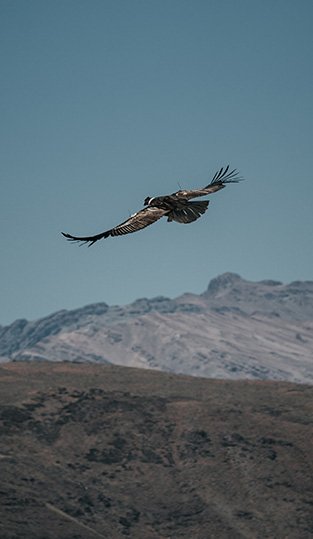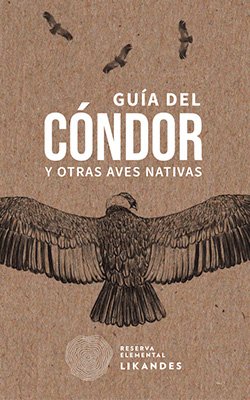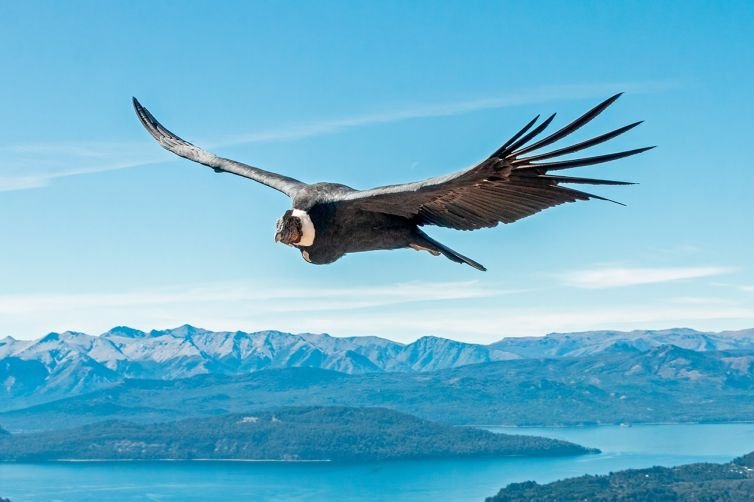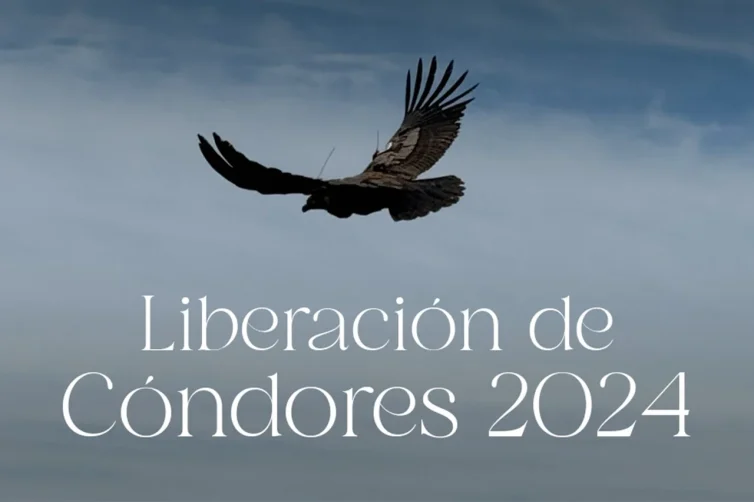History
For centuries, the Andean condor has been one of the most charismatic and culturally influential species for Andean people. This, coupled with the fact that condors inhabit both natural and anthropized territories, makes them an umbrella and flagship species that is key to the conservation objectives of the entire Andean ecosystem.
With this in mind, in 2019, MERI Foundation identified the Andean condor as a key Conservation Target within Chile’s terrestrial ecosystems. Since then, MERI, the Union of Ornithologists of Chile, and the Manku Project, have been working on an effective conservation model based on three lines of action: scientific research, environmental education, and advocacy in partnership with local communities. These efforts aim to minimize knowledge gaps and threats to this species and its ecosystem, and to strengthen the active role of the community, and society as a whole, in its conservation.
In 2019, MERI Foundation created the first Condor Pre-Release Center in Chile, located in the Likandes Elemental Reserve in the Metropolitan Region. This was a milestone in its commitment to the protection and study of this conservation target . The condors that are released are fitted with harmless satellite transmitters that allow scientists to monitor and evaluate how they are and to understand how condors use the territory in order to study them, protect them, and address their current and future threats.
In order for children and adults to learn more about this ecosystem guardian and its threats, an environmental education program was created together with an “Educational Guide to the Condor and Other Native Birds.” The program has already reached schools in central and southern Chile and in Chilean Patagonia, along with other specific activities involving other civil society stakeholders. The goal is to get Chileans to care deeply about condors and to support an ecosystemic approach that allows us to coexist with ecosystems and their inhabitants.
Vuela hasta 7.000 metros de
altura con un planeo perfecto,
aprovechando corrientes de aire
Sabías que…
El cóndor puede cubrir hasta
350 km por día en vuelo.
Si ves una gran ave de color negro
en los cielos, posiblemente estés
viendo uno!
Our Contributions to the Conservation of the Andean Condor
1. Scientific Research:
Satellite Transmitters
Satellite transmitters are a non-invasive tool used to identify condor movement patterns and thereby define key areas of condor habitat use, such as feeding areas, roosting areas, nests, flight corridors, wintering and summering areas, etc., in order to assess their situation and main threats.
Condor Ecovirology
With the support of MERI Foundation, Dr. Gonzalo Barriga from the Faculty of Medicine of Universidad de Chile conducted an ecovirological study focused on condors. The project aimed to help identify the different families of viruses that affect this species and other native avifauna, and to determine how the environment and the behavior of the condor as it moves between Chile and Argentina, acting as a connecting host, could influence this process. This collaboration resulted in a thesis entitled “Ecovirology of the Andean Condor: Analysis of Viral Diversity and its Impact on Native Avifauna.”
Thesis Abstract

This study opens the door for further research on condor health, including identifying the diet of wild condors, and being able to determine whether birds are immuno-depressed or ill prior to release. If the COVID-19 pandemic has taught us anything, it is the importance of monitoring wild animals from the perspective of molecular biology and as a tool to continue protecting the majestic Andean Condor.
2. Environmental Education:
Condor Educational Program
The educational program consists of workshops taught using fun methodologies that allow students from Pre-K to 6th grade to bond with the birds that live in their territory and, in particular, with the condor and its protection.
It includes 3 modules and is also complemented by didactic materials such as the condor educational guide.
Program Details
Cajón del Maipo.
– The program was carried out in 7 schools in the Municipality of San José de Maipo and reached more than 100 fourth grade students.
Cajón del Maipo.
– The program was carried out in 6 municipal schools with 167 fourth grade students.
Pucón
– The program was carried out in 8 municipal and rural schools (Villarrica, Pucón, and Curarrehue).
– 130 fourth grade students were taken to see condors in their natural habitat.
Patagonia
– The program was carried out in 4 schools around the Patagonia National Park with third and fourth grade students.
– The educational program for the release of condors was carried out with the Cochrane community.
– An outreach campaign was conducted through radio stations, communities, Conaf, and municipalities.
– The program was not conducted due to the pandemic.
Cajón del Maipo
– The program was carried out in 6 municipal schools with 167 third and fourth grade students.
3. Local Community Outreach
Informative talks have been given with emphasis on areas where condors are present. An outreach campaign was conducted through radio stations, communities, Conaf, and municipal governments.
Pre-liberation Center in the Likandes Elemental Reserve
The Likandes Elemental Reserve is located in the Metropolitan Region, in the Maipo River basin, where a high population of condors and humans coexist. The reserve is used as a base from which to address a series of questions and problems related to condor conservation in central Chile, and to develop cultural and awareness-raising activities about the condor for a primarily urban population.
Four condor releases have been carried out, three in the Cajón del Maipo and one in Patagonia, with 11 condors released, nine of which were successfully released. One failed to adapt to the wild, and another did not survive the release.
*Not all condors were released with satellite transmitters.
Condor Release
In 2019, MERI became a partner of the Aves Chile UNORCH Manku Project.
The objective of the project is to protect the species through environmental education, science for conservation, and adaptation of birds rehabilitated by the CRAR for their later reintegration into nature.
In most Andean countries, efforts are being made to protect condors. In Chile, UNORCH has worked for 25 years in condor management, captive breeding, rehabilitation, and release.
MERI Foundation joined in 2019 to promote the reintroduction of rehabilitated condors through the creation of the first condor pre-release center. In addition, MERI has created an educational program and a guide designed especially for this project and has provided satellite technology for the study of condors’ movement patterns.
The goal is to understand the condor’s use of the territory in order to study them, protect them, and address their current and future threats.
In total, four releases have been carried out, three in Cajón del Maipo and one in Patagonia, with 11 condors released.
Release Details
Two condors were released in the Patagonia National Park.
Liquid H-174
– Female
– Born in winter 2020
– Origin: Panguipulli
– Cause: Found unable to fly and in poor condition
– Successfully released in February 2022
Pumalin M 173
– Male
– Born in winter 2020
– Origin: Pumalin
– Cause: Found unable to fly
– Successfully released in February 2022
M-142
– Male
– Born on December 1, 2016
– Origin: Born at the CRAR
– Cause: Offspring of non-releasable parents from the CRAR
– Successfully released in December 2021
M-167
– Male
– Born in spring 2016
– Origin: Camino International [International Highway], Valparaiso Region
– Cause: Found with minor right wing injury, unable to fly
– Successfully released in December 2021
M-168
– Male
– Born on December 6, 2019
– Origin: Born at the CRAR
– Cause: Offspring of non-releasable parents from the CRAR
– Successfully released in December 2021
H-136
– Female
– Born in spring 2015
– Origin: Las Cabras, Maule Region
– Cause: Right wing gunshot injury
– Successfully released in 2020
H-139.
– Female
– Born in spring 2016
– Origin: Valparaíso Region
– Cause: Found unable to fly
– Successfully released in 2020
H-146
– Female
– Born in spring 2015
– Origin: Camino Farellones
– Cause: Ulmo fracture
– Released in 2020, did not survive the release
Wilka: H-123, ship 06DF-07B6
– Female
– Born in spring 2013
– Origin: Coyhaique
– Cause: Unknown
– Released on December 12, 2019, and recaptured on January 3, 2020, weak, returned to the CRAR
Maipo 196195 T
– Male
– Born in March 2014
– Origin: Aysén
– Cause: Found unable to fly
– Successfully released in 2019, moving area: Cajón del Maipo
-Eluney 196196
– Male
– Born in September 2014
– Origin: Cordillera San Fabian, Ñuble Region
– Cause: Found unable to fly
– Successfully released in 2019, moving area: Cajón del río Maule
The releases have been supported by the educational program “Guardians of the Condor,” which was designed especially for this project together with the GUIDE TO THE CONDOR.
The program has been carried out in the central, southern, and Chilean Patagonia areas. It seeks to generate a connection between the condor, the population, and children.
Humans are the greatest threat to condors, which is why we hope to empower, teach, and change habits in the population in order to generate a healthy coexistence between the ecosystems and their inhabitants.
Of the 11 condors that have been released:
- Nine were successfully released.
- One failed to adapt to the wild.
- One did not survive the release.
*Not all condors were released with satellite transmitters.










